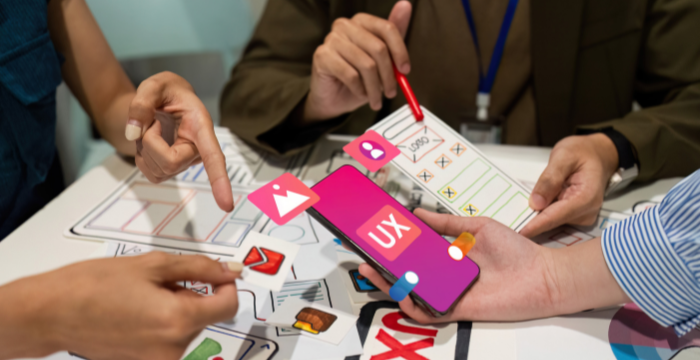In the digital age, where users are bombarded with countless applications and websites, design reigns supreme. It’s the magic that draws users in, fosters engagement and determines a product’s success.
In product design, UI and UX are the most confused and conflated terms. Both terms are used interchangeably which is not true. They both have different meanings and importance. But what exactly is this magic behind the curtain? Buckle up as I am going to explain the hidden concepts of these two terms in a remarkably simple and logical way.
In this first blog, I will explain the concept of user interface (UI) and user experience (UX) along with the differences and responsibilities of UI and UX designers:
Understanding User Interface (UI):
The user interface (UI) is the art of visual appeal. It is the external appearance of the application. It is the thing which the user interacts with directly, the first layer which impresses the user. UI design focuses on making the product aesthetically pleasing, easy to understand, and intuitive to use.
The user interface (UI) includes the colours, fonts, format of fonts, icons and overall graphics design, headers, and sliders.
Understanding User Experience (UX):
UX is the broader picture. It encompasses the entire experience a user has when interacting with a product. This includes how easy it is to use, how efficient it is in achieving a task, and how enjoyable it is to interact with. UX design considers the user’s needs, emotions, and motivations throughout their journey with the product.
The main goal of a UX designer is for users to enjoy a product or service. Whether the encounter solves an issue, entertains, or informs, the user should feel satisfied.
Difference Between UI/UX:
Still confused about what is the main difference between them. Imagine you are walking into a beautiful, aesthetic, and artistic restaurant. You are amazed by the art done in the restaurant, the classy design of the tables and cutlery – its UI. The service quality, food taste and entire dining experience- it is the UX.
The following illustration explains a comprehensive difference between them:
Essential of UI/UX Design:
1. Simplicity:
In today’s fast-paced world, users crave concise and simple experiences. A clear interface which is free from unnecessary elements and information is what a user wants and needs. Simplicity in the user interface will help the user with what to do and how to do it at first glance.
2. Usability:
This is the foundation of a good user experience. A well-designed interface (UI/UX) should be intuitive and easy to navigate. Users shouldn’t have to struggle to find what they are looking for or complete tasks. Focus on clear labelling, consistent layout, and intuitive interactions.
3. Response and Correctness:
Answering the user’s commands quickly and efficiently is what the user wants in an application. This is where User experience (UX) comes into play, this plays a significant role in enabling rapid and quick application navigation.
4. Accessibility:
In today’s fast-paced world, it’s crucial to ensure your UI/UX design caters to users with disabilities. This includes features like screen reader compatibility, high-contrast themes, and keyboard navigation. By prioritizing accessibility, you reach a wider audience and create a more positive user experience for everyone.
Roles And Responsibilities Of UI Designer:
UI designers work on the visual elements of user interfaces. They manage how the website looks and feels, creating guidelines for web designers and web developers to follow.
They design webpages and mobile applications and also determine what is shown on the page. A UI designer can work with a UX designer to make sure a product is usable, effective, and intuitive.
UI designers typically have a background in design, and they use their skills to create interfaces that are both beautiful and user-friendly.
Roles And Responsibilities Of UX Designer:
UX designers are the ones who create and keep the overall design of the product. They oversee the interface, navigation, graphics, and overall user experience.
They also make sure that the product is usable by all types of users. They also take care of accessibility issues and make sure that people with disabilities can use the product easily.
Career Opportunities of UI/UX Designer:
For every UI and UX designer, there are a plethora of opportunities present in the tech world. a few are listed below:
1. UI Designer:
They are creative minds behind the interface. Their ability lies in translating user needs and brand guidelines into engaging, intuitive interfaces that are not only visually appealing but also functionally sound. UI designers use design software and prototyping tools to bring their concepts to life, ensuring a seamless user journey.
2. UX designer:
UX designers champion the user’s perspective throughout the design process. They have strong research skills, employing user interviews, surveys, and usability testing to understand user needs, behaviours, and pain points. From crafting user flows and wireframes to creating prototypes, UX designers map out intuitive user journeys.
Join Decklaration as a UX Designer. They will provide you with an engaging and exciting environment to learn and enhance your skills in conducting in-depth research on user needs, understanding market trends and making viable strategies for designing.
3. UI/UX Designer:
The UI/UX designer is an asset, having a comprehensive skillset that encompasses both UI and UX ability. They can seamlessly translate user needs into visually appealing interfaces while prioritizing usability and information architecture. This hybrid role is in high demand, as companies increasingly recognize the importance of a user-centered approach to design.
Join Nexterse as a UI/UX Designer. You will conduct in-depth research to understand user needs and translate them into exceptional user experiences. This is your chance to make a real impact on the products used by millions.
4. Information Architect:
Information architects are the behind-the-scenes heroes of user-friendly interfaces. They excel at structuring and organizing data logically and intuitively. Their focus lies on content labelling and arrangement, ensuring users can effortlessly navigate and find the information they seek. Information architects play a crucial role within the UX design field, contributing to a smooth and efficient user experience.
To conclude, UI and UX design differences and concepts are clear now. Although, they go hand-in-hand, but both have specific peculiarities which as a techie you must have to know. UI is an appealing visual design and UX, user experience and interaction with the application.
Do you want an amazing and aesthetic design for your mobile and web applications? Do you want attractive cards and vouchers to promote your business in the digital world? Or Do you want to learn the concepts of various tech-related topics? Don’t be stressed, Nexterse is here to answer all your queries, help enhance your business and provide you with services for mobile and product design.
It’s just a start, stay connected with us to learn and expand your mental space regarding designing concepts.

